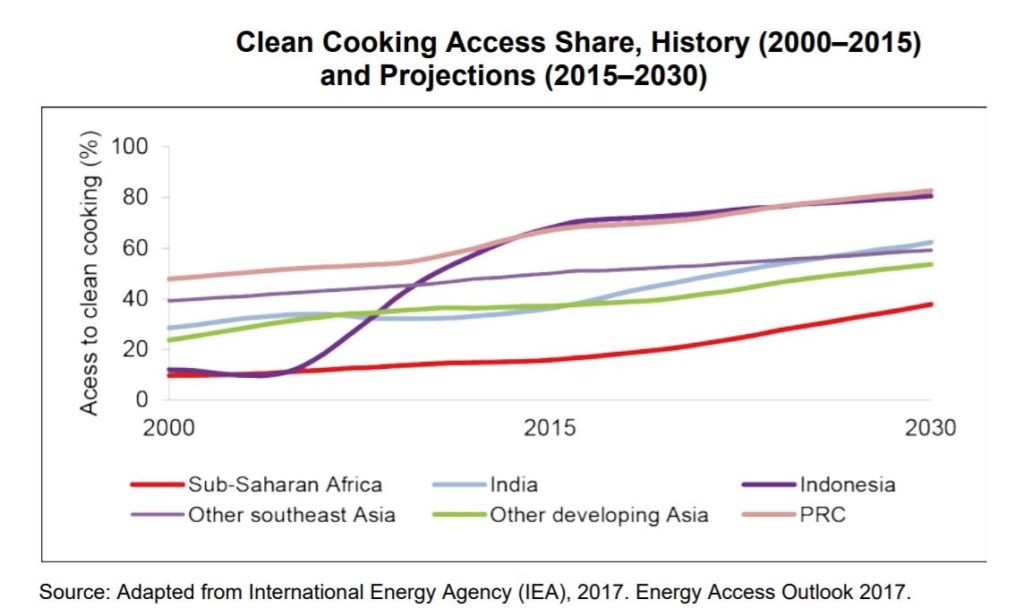Why Clean Cooking Is Not Always Climate Friendly
Photo Credit: UNDP
26 October 2021 – by Ankush Kumar Comments (0)
Clean cooking is a hot topic issue in development, and rightly so. Globally, millions have no access to modern cooking facilities, with most relying on traditional fuels. This reliance is causing unimaginable casualties and health problems, especially for women and children.
While there is progress in making clean cooking universal, a significant chunk rests on using liquified petroleum gas (LPG). From a climate perspective, this is not good news, as LPG is a fossil fuel. However, there are alternatives.
Clean Cooking’s Definition Needs an Update
In 2020, the World Bank’s Energy Sector Management Assistance Programme stated that the use of electricity and liquified petroleum gas (LPG) provided an equally clean cooking environment – alongside the likes of solar cookers and biogas. In 2021, the Energy Progress Report added by reporting on the UN’s Sustainable Development Goal 7 with praise for LPG and the broader use of electricity in cooking options.
The definition is, however, understandable from a health perspective. Over 2.5 billion people globally still use solid fuels like wood, animal dung, crop waste and coal. The use of “traditional” fuels culminate in the causes of around 4 million annual deaths from air pollution, according to the World Health Organization (WHO). Particularly affected are women and children with 45% of all pneumonia deaths under five relating to indoor air pollution.
However, both LPG and cooking with electricity sourced from fossil fuels are by definition dirty from a climate perspective.
Clean Cooking from a Climate Perspective
Whilst accepted and adopted before the Paris Agreement in 2015, clean cookings definition does not reflect the global movement to reduce carbon emissions. So, can LPG indeed be considered an option in a world pledging ambitious targets for net-zero emissions?
Many international bodies pushing for stricter energy and climate-friendly policies like the World Bank, International Energy Agency (IEA) and the International Renewable Energy Agency (IRENA) still include LPG in their clean cooking vision. Between 2015 and 2020, for instance, The World Bank’s Efficient Clean, Cooking and Heating programme – where LPG had a prominent role – totalled over USD 400 million spread over 21 countries.
The justification is that fossil fuels, like LPG, are a transition fuel that can make other forms of cooking more cost-competitive. This repeated argument, used by the fossil fuel industry, leads to massive subsidies in the name of clean cooking.
In India, for instance, the government has invested billions into LPG programmes and subsidies to reduce dependencies on traditional fuels. Yet, despite the LPG subsidies, hundreds of millions of people in India still rely on traditional fuels due to financial barriers, limited access to bank accounts, and supply issues.
From a climate perspective, subsidising another fossil fuel does not align with the Paris Agreement’s goal of slashing carbon emissions.

What Should be Next
Bearing this in mind, clean cooking’s definition in the context of the Paris Agreement needs an update. This would mean dispelling the vast majority of clean cooking that is dependent on fossil fuels like LPG.
So far, international bodies have committed to universal access to clean cooking by 2030, raising USD 500 million. However, this figure is a far cry from actual funding estimates to what clean cooking requires, which sits at USD 1.5 trillion to achieve 2030’s goals for universal clean cooking – or USD 148-156 billion annually over the next ten years.
While LPG powered cooking is cleaner compared to traditional fuels, more support on alternatives to fossil fuel-based cooking is needed. Solar cookers, biogas, or electronic powered cookers with energy from renewables need the backing occupied by subsidies for LPG.
From this perspective, clean cooking does not have to sacrifice climate goals for development goals. Instead, the two can work hand-in-hand to support the betterment of the planet and people in need – saving millions of lives, reducing our fossil fuel usage, and becoming a step closer to a carbon-free world.





